Developing a Sustainable Digital Transformation Roadmap for SMEs: Integrating Digital Maturity and Strategic Alignment
Abstract
1. Introduction
2. Methodology
2.1. Systematic Literature Review (SLR)
2.2. Roadmap Development
2.3. Roadmap Validation
- Planning and Preparation: The first step involved planning the data collection process, which included creating templates, developing questions for semi-structured interviews, and preparing questionnaires to be applied after the assessment to gather feedback on the applicability of the roadmap.
- Assessments and Data Collection: Step 1 of the roadmap was initiated, where digital transformation objectives were defined in collaboration with senior management. Following this, Step 2 was implemented to assess the company’s current maturity level. Data collection involved conducting semi-structured interviews (detailed in Appendix A) and gathering direct evidence, such as company documents, records, IT strategies, plans, tools in use, and collected metrics. Each process was outlined alongside its respective activities, and all participants jointly reviewed their applicability and relevance to the company. The activities were evaluated on a scale from zero (Not Achieved) to three (Fully Achieved) based on their completion and supporting evidence.
- Analysis: The interviews were transcribed, and direct evidence was reviewed to analyze the data. This analysis provided insights into the capability level of each process within the company and, consequently, the overall organizational maturity level.
- Results Validation: In the final stage, the results were shared with senior management in a dedicated session where the findings were discussed in detail. This discussion highlighted key strengths and weaknesses within the company’s digital transformation journey, and an action plan was developed to address identified gaps. Feedback from key stakeholders connected to the SME was solicited. This feedback was crucial for assessing the practical implementation of the roadmap and enhancing its relevance and effectiveness.
Statistical Analysis of the Interviews
3. The SDT-SMEs Roadmap
3.1. Process Reference Model (PRM)
- Digital Technologies: This dimension focuses on how technology drives digital transformation. Digitalization refers to the application of digital technologies to modify a business model, creating new opportunities for revenue generation and value creation. It involves enhancing an organization’s efficiency, effectiveness, and agility through these technologies. This is achieved by integrating technologies and processes across manufacturing and the supply chain, enabling decentralized decision-making and autonomous production with minimal human intervention. Notably, the adoption of advanced technologies like artificial intelligence (AI), machine learning, and blockchain is crucial for increasing company value and performance [49,50,51].
- Customer Focus: Digital transformation improves customer experience by offering user-friendly designs and boosting service reliability, which strengthens customer loyalty. Digital platforms play a pivotal role in the digital transformation of SMEs, facilitating communication and collaboration with clients and suppliers. They also enable companies to explore new markets and experiment with different business models. High-speed networks allow SMEs and entrepreneurs to connect with suppliers and customers, access real-time information on market conditions both locally and globally, and monitor consumer demand. This connectivity allows for rapid responses to market changes and supply chain disruptions. Personalized and engaging digital experiences, combined with data analytics and targeted automation, further enhance customer satisfaction and loyalty. Manufacturing companies must remain agile, flexible, and innovative to keep pace with changing market dynamics, as customer needs have become more diverse and products more complex and intelligent [52,53,54].
- Organizational Culture: The internal dynamics of an organization, along with collaborative networks, form the foundation of its structure. A lack of a strong digital culture can lead to the failure of any digital transformation initiative. Leadership plays a vital role in cultivating this culture by setting an example and fostering an environment that embraces change, which is essential for fostering innovation. Digitalization is reshaping how SMEs operate, disrupting traditional methods of delivering value to customers through new channels and altering business operations. Investing in resources and promoting continuous innovation is crucial for staying competitive in the fast-evolving digital landscape [55,56,57].
- Organizational Governance: Research underscores the importance of effective governance structures in ensuring the success of digital transformation strategies. Governance frameworks that support strategic decision-making and resource allocation, particularly to evolving digital capabilities like innovation, are essential for digital transformation success in SMEs. Additionally, companies with well-defined digital strategies often exhibit stronger governance practices, as supported by emerging literature. This suggests that certain Governance, Accountability, and Compliance (GAC) variables within SMEs positively impact performance when technology is embraced. Effective governance is critical for aligning digital transformation initiatives with strategic goals and operational efficiency [57,58,59,60].
- People: Human capital is a key component of digital transformation. The flexibility and innovative capacity of employees are essential to enhancing organizational capabilities. Promoting knowledge sharing, employee training, and effective communication mechanisms for continuous improvement are necessary. These factors prepare an organization for successful digital transformation, fostering organizational agility, a leadership team that understands the strategic implications of technology, and more empowered employees who actively contribute to the transformation. Additionally, gender diversity within teams appears to play an important role in stimulating creativity and innovation [11,61,62,63].
- Sustainability: Sustainability is a fundamental pillar of sustainable digital transformation, as it integrates technological advancements with practices that promote environmental, social, and economic responsibility. The intersection between sustainability and digital transformation is driven by emerging technologies that enhance the competitive advantage of companies, not only by improving operational efficiency but also by aligning business operations with sustainability goals. SMEs, in particular, are leveraging Industry 4.0 technologies, such as the Internet of Things (IoT) and additive manufacturing, to reduce environmental impacts, improve economic performance, and promote social responsibility practices. The adoption of digital tools facilitates innovation, customization, and process optimization, enabling SMEs to achieve their sustainability objectives more effectively, while also meeting the demands of a market that is increasingly conscious and regulated by environmental and social standards. Thus, sustainability plays a role in digital transformation by guiding business strategies towards more responsible and resilient growth, which respects ecological boundaries and promotes social well-being [64,65,66].
3.2. The SDT-SMEs Maturity Model
3.2.1. Process Capability Levels
- (0)
- Not Achieved—if the achievement is between 0% and 15%;
- (1)
- Partially Achieved—if the achievement is between 16% and 50%;
- (2)
- Largely Achieved—if the achievement is between 51% and 85%;
- (3)
- Fully Achieved—if the achievement level is between 86% and 100%.
3.2.2. Organizational Maturity Level
- Level 0: There is no SDT initiative.
- Level 1: Initial—The sustainable digital transformation process has started [42]. The organization is implementing basic processes. The SDT vision is established, and the roadmap for the transition strategy has been developed but not yet fully implemented. Fundamental processes such as using basic technologies and social media platform management are in development. Customer communication and interaction begin to take place via digital platforms, with an emphasis on information sharing and customer engagement. Additionally, this level focuses on fostering a culture of innovation and increasing employee acceptance of digitalization.
- Level 2: Managed—Sustainable digital transformation management occurs at this stage, when a connection between the physical and digital worlds, is created [42]. Core processes are initiated, such as implementing IT infrastructure, managing information systems, ensuring connectivity, and utilizing cloud computing. Digital marketing strategies and customer engagement plans are developed, alongside promoting digital culture and innovation. The organization also manages its digital strategies at this level.
- Level 3: Defined—Sustainable digital transformation is well-established within the company at this level. More advanced processes are developed, including the integration of digital technologies, the use of AI, data analytics, e-commerce, and customer experience enhancement. Organizational culture adapts through change management practices and e-business strategies. Partnerships with educational institutions are established, while there is greater involvement from stakeholders, support from top management, and increased employee participation.
- Level 4: Digital Oriented—Advanced processes are developed to unify software, perform simulations, and implement technologies. Security is strengthened using blockchain, while Big Data and machine learning provide real-time insights and manage traceability. Internal innovation is promoted, organizational change capability is strengthened, and the digitalization of processes and services progresses. Investment in innovation, government support, partnerships, and collaboration are encouraged, while digital expertise and capacity-building are enhanced under transformational leadership. Corporate sustainability and digitalization are advanced, and agile manufacturing practices and innovation are adopted. Research and development (R&D) is intensified, managing cooperation between humans and AI, while sustainable learning management is promoted.
4. Validation of the SDT-SMEs Roadmap—A Case Study
5. Results and Discussion
- Vision: To be a company with sustainability practices, it should be digitally structured to enhance process efficiency and internal value, while also improving customer service to increase market profitability. We focus on minimizing environmental impact, automating paperwork, and utilizing digital channels. This approach enables us to streamline operations and extend our reach to a global client portfolio.
- Specific and Measurable Objectives: The following objectives were set.
- o
- Automating Administrative Processes—Decrease time spent on administrative tasks by 30% in the first six months.
- o
- New Client Acquisition—Increase the number of clients from digital channels by 20% within the first year.
- o
- Enhance Customer Satisfaction—Implement a digital customer service system and look to increase satisfaction rates by 15% in the first year.
- o
- Streamline Internal Processes—Implement digitalization and automation within 12 months to minimize manual errors in internal processes.
- o
- Implement a Digital Waste Management System to reduce waste by 20% by the end of the second year.
- o
- Train 100% of employees in digital and sustainable competencies by the end of the second year.
- Motivation: The main motivation is to ensure a more efficient company that is prepared for an increasingly digital market, where automation and online presence are essential for evolution and customer acquisition. Moreover, integrating sustainability with digitalization not only makes processes more efficient and cost-effective but also enhances the firm’s brand perception, potentially attracting customers and partners who value sustainable practices.
Discussion of the Proposed Roadmap
6. Conclusions
Author Contributions
Funding
Institutional Review Board Statement
Informed Consent Statement
Data Availability Statement
Conflicts of Interest
Appendix A
Appendix B
| Dimension | Process | Papers |
|---|---|---|
| Digital Technologies | Use Basic Technologies | [56] |
| Manage Social Media Platforms | [56] | |
| Implement IT infrastructure | [70] | |
| Manage Information Systems | [70] | |
| Ensure Connectivity | [56] | |
| Guarantee Interoperability | [33,71] | |
| Integrate Digital Technology | [56,70] | |
| Facilitate Industrial System Integration | [72] | |
| Unify Horizontal and Vertical Software Integration | [73] | |
| Utilize Cloud Computing | [73,74,75] | |
| Apply Artificial Intelligence (AI) | [12,74,75] | |
| Utilize Data Analytics | [52,73] | |
| Conduct Simulations | [73] | |
| Deploy Internet of Things (IoT) | [12,74,75,76] | |
| Implement Augmented Reality | [51] | |
| Secure with Cybersecurity using Blockchain | [73,75] | |
| Utilize Big Data | [52,73] | |
| Utilize Machine Learning | [12] | |
| Adopt Additive Manufacturing | [73,75] | |
| Create Digital Twins | [73] | |
| Develop Cyber-Physical Systems (CPS) | [76] | |
| Implement Autonomous Robots | [74,75] | |
| Customer Focus | Use of Digital Platforms | [11] |
| Implement e-Commerce | [49,56] | |
| Provide Real-time Information | [56,77] | |
| Manage Product Iraceability | [56] | |
| Share Information and Interact with Customers | [12] | |
| Develop Digital Marketing Strategies | [70,78] | |
| Promote Customer Engagement and Loyalty | [41] | |
| Enhance Customer Experience | [49,70,79] | |
| Customize Products and Services | [49,52] | |
| Organizational Culture | Foster a Culture of Innovation | [70] |
| Develop Digital Culture | [12,49] | |
| Encourage Open Innovation | [80] | |
| Promote an Adaptive Organizational Culture | [77] | |
| Implement Internal Innovation Processes | [80] | |
| Apply Change Management Practices | [49,79] | |
| Improve Organizational Adaptability | [70] | |
| Build Organizational Change Capacity Processes | [79] | |
| Digitalization Well-accepted by the Workers | [77] | |
| Drive Digitalization of Processes and Services | [77] | |
| Adopt E-business Strategies | [81] | |
| Advance Corporate Sustainability and Digitalization | [49] | |
| Implement Agile Manufacturing and Innovation | [49] | |
| Organizational Governance | Develop Strategic Vision | [16,49] |
| Manage Organisational Leadership | [70,77] | |
| Manage Strategies and Their Financial Aspects | [49] | |
| Evaluate Overall Performance | [49] | |
| Formulate Digital Strategy | [50] | |
| Define Differentiating Ideas | [50] | |
| Define Portfolio | [50] | |
| Invest in Innovation | [49] | |
| Conduct R&D (Research and Development) | [70,79] | |
| Engage Stakeholders | [70,79,82] | |
| Seek Government Support | [11,83] | |
| Forge Collaboration and Partnership | [11] | |
| Establish University-Industry Partnerships | [84] | |
| People | Develop Digital Skills for all Employees | [16,49,50,56,70,82] |
| Enhance Information and Digital Technology Expertise | [16,50] | |
| Manage Human–AI Cooperation | [73] | |
| Promote Continuous Training | [16,49,56,79] | |
| Manage Education and Capacity Building | [11,81] | |
| Manage Sustainable Learning Management | [49] | |
| Ensure Effective Communication | [85,86] | |
| Manage Work Teams (inter/intra communication) | [70] | |
| Develop Management Skills | [85] | |
| Encourage Employee Participation | [82] | |
| Ensure Support from the Top Management Team | [16,86] | |
| Exercise Transformational Leadership | [16,70,77] | |
| Sustainability | Implement Green IT Practices | [86] |
| Monitor Carbon Footprint | [86] | |
| Optimize Resource Efficiency | [87] | |
| Implement Digital Environmental Monitoring | [87] | |
| Utilize Renewable Energy Sources | [88,89] | |
| Adopt Sustainable Procurement | [36,37] | |
| Promote Circular Economy Practices | [36,37,90] | |
| Conduct Sustainability Reporting | [86] | |
| Sustainable Product Design | [89,90] |
References
- Tavana, M.; Shaabani, A.; Raeesi Vanani, I.; Kumar Gangadhari, R. A review of digital transformation on supply chain process management using text mining. Processes 2022, 10, 842. [Google Scholar] [CrossRef]
- Rahmani, R.; Jesus, C.; Lopes, S.I. Implementations of Digital Transformation and Digital Twins: Exploring the Factory of the Future. Processes 2024, 12, 787. [Google Scholar] [CrossRef]
- Kaftan, V.; Kandalov, W.; Molodtsov, I.; Sherstobitova, A.; Strielkowski, W. Socio-economic stability and sustainable development in the post-COVID era: Lessons for the business and economic leaders. Sustainability 2023, 15, 2876. [Google Scholar] [CrossRef]
- George, G.; Merrill, R.K.; Schillebeeckx, S.J.D. Digital Sustainability and Entrepreneurship: How Digital Innovations Are Helping Tackle Climate Change and Sustainable Development. Entrep. Theory Pract. 2021, 45, 999–1027. [Google Scholar] [CrossRef]
- Guandalini, I. Sustainability through digital transformation: A systematic literature review for research guidance. J. Bus. Res. 2022, 148, 456–471. [Google Scholar] [CrossRef]
- Andriushchenko, K.; Buriachenko, A.; Rozhko, O.; Lavruk, O.; Skok, P.; Hlushchenko, Y.; Muzychka, Y.; Slavina, N.; Buchynska, O.; Kondarevych, V. Peculiarities of sustainable development of enterprises in the context of digital transformation. Entrep. Sustain. Issues 2020, 7, 2255–2270. [Google Scholar] [CrossRef]
- Carnerud, D.; Mårtensson, A.; Ahlin, K.; Slumpi, T.P. On the inclusion of sustainability and digitalisation in quality management—An overview from past to present. Total Qual. Manag. Bus. Excell. 2020, 1–23. [Google Scholar] [CrossRef]
- Flyverbom, M.; Deibert, R.; Matten, D. The Governance of Digital Technology, Big Data, and the Internet: New Roles and Responsibilities for Business. Bus. Soc. 2019, 58, 3–19. [Google Scholar] [CrossRef]
- Ghobakhloo, M. Industry 4.0, digitization, and opportunities for sustainability. J. Clean. Prod. 2020, 252, 119869. [Google Scholar] [CrossRef]
- Zhang, Y.; Jin, S. How does digital transformation increase corporate sustainability? The moderating role of top management teams. Systems 2023, 11, 355. [Google Scholar] [CrossRef]
- Bühler, M.M.; Calzada, I.; Cane, I.; Jelinek, T.; Kapoor, A.; Mannan, M.; Zhu, J. Unlocking the power of digital commons: Data cooperatives as a pathway for data sovereign, innovative and equitable digital communities. Digital 2023, 3, 146–171. [Google Scholar] [CrossRef]
- Sang, T.M. Digital transformation toward sustainable development in Vietnamese small and medium enterprises. Manag. Mark. 2023, 18, 459–473. [Google Scholar] [CrossRef]
- Cichosz, M.; Wallenburg, C.M.; Knemeyer, A.M. Digital Transformation at Logistics Service Providers: Barriers, Success Factors and Leading Practices. Int. J. Logist. Manag. 2020, 31, 209–238. [Google Scholar] [CrossRef]
- Nyagadza, B. Sustainable Digital Transformation for Ambidextrous Digital Firms: A Systematic Literature Review and Future Research Directions. Sustain. Technol. Entrep. 2022, 1, 100020. [Google Scholar] [CrossRef]
- Chen, Y.Y.K.; Jaw, Y.L.; Wu, B.L. Effect of digital transformation on organisational performance of SMEs: Evidence from the Taiwanese textile industry’s web portal. Internet Res. 2016, 26, 186–212. [Google Scholar] [CrossRef]
- Teng, X.; Wu, Z.; Yang, F. Research on the relationship between digital transformation and performance of SMEs. Sustainability 2022, 14, 6012. [Google Scholar] [CrossRef]
- Packmohr, S.; Brink, H.; Paul, F.H. Unraveling perceptions of barriers to digital transformation–contrasting small and medium-sized with large enterprises. IADIS Int. J. Comput. Sci. Inf. Syst. 2023, 18, 102–119. [Google Scholar]
- Birkel, H.; Wehrle, M. Small-and medium-sized companies tackling the digital transformation of supply chain processes: Insights from a multiple case study in the German manufacturing industry. IEEE Trans. Eng. Manag. 2022, 71, 13711–13726. [Google Scholar] [CrossRef]
- Kallmuenzer, A.; Mikhaylov, A.; Chelaru, M.; Czakon, W. Adoption and performance outcome of digitalization in small and medium-sized enterprises. Rev. Manag. Sci. 2024, 1–28. [Google Scholar] [CrossRef]
- Stentoft, J.; Adsbøll Wickstrøm, K.; Philipsen, K.; Haug, A. Drivers and barriers for Industry 4.0 readiness and practice: Empirical evidence from small and medium-sized manufacturers. Prod. Plan. Control 2021, 32, 811–828. [Google Scholar] [CrossRef]
- Kumar, V.; Vrat, P.; Shankar, R. Factors influencing the implementation of industry 4.0 for sustainability in manufacturing. Glob. J. Flex. Syst. Manag. 2022, 23, 453–478. [Google Scholar] [CrossRef]
- Ero, S.; Schumacher, A.; Sihn, W. Strategic guidance towards Industry 4.0–a three-stage process model. Int. Conf. Compet. Manuf. 2016, 9, 495–501. [Google Scholar]
- Merz, S.L.; Siepmann, D. Industrie 4.0–Vorgehensmodell für die Einführung. In Einführung und Umsetzung von Industrie 4.0; Springer Gabler: Berlin/Heidelberg, Germany, 2016; pp. 83–132. [Google Scholar]
- Hermann, M.; Pentek, T.; Otto, B. Design principles for industrie 4.0 scenarios. In Proceedings of the 49th Hawaii International Conference on System Sciences (HICSS), Koloa, HI, USA, 5–8 January 2016; IEEE: New York, NY, USA, 2016; pp. 3928–3937. [Google Scholar]
- Cho, Y.; Yoon, S.P.; Kim, K.S. An industrial technology roadmap for supporting public R&D planning. Technol. Forecast. Soc. Chang. 2016, 107, 1–12. [Google Scholar]
- Matt, D.T.; Rauch, E.; Riedl, M. Knowledge transfer and introduction of Industry 4.0 in SMEs: A five-step methodology to introduce Industry 4.0. In Analyzing the Impacts of Industry 4.0 in Modern Business Environments; IGI Global: Hershey, PA, USA, 2018; pp. 256–282. [Google Scholar]
- Pessl, E.; Sorko, S.R.; Mayer, B. Roadmap Industry 4.0–implementation guideline for enterprises. Int. J. Sci. Technol. Soc. 2017, 5, 193. [Google Scholar] [CrossRef]
- Ghobakhloo, M. The future of manufacturing industry: A strategic roadmap toward Industry 4.0. J. Manuf. Technol. Manag. 2018, 29, 910–936. [Google Scholar] [CrossRef]
- Garzoni, A.; De Turi, I.; Secundo, G.; Del Vecchio, P. Fostering digital transformation of SMEs: A four levels approach. Manag. Decis. 2020, 58, 1543–1562. [Google Scholar] [CrossRef]
- Brozzi, R.; Rauch, E.; Riedl, M.; Matt, D.T. Industry 4.0 roadmap for SMEs: Validation of moderation techniques for creativity workshops. Int. J. Agil. Syst. Manag. 2021, 14, 276–291. [Google Scholar] [CrossRef]
- Han, H.; Trimi, S. Towards a data science platform for improving SME collaboration through Industry 4.0 technologies. Technol. Forecast. Soc. Chang. 2022, 174, 121242. [Google Scholar] [CrossRef]
- Ghobakhloo, M.; Iranmanesh, M.; Vilkas, M.; Grybauskas, A.; Amran, A. Drivers and barriers of industry 4.0 technology adoption among manufacturing SMEs: A systematic review and transformation roadmap. J. Manuf. Technol. Manag. 2022, 33, 1029–1058. [Google Scholar] [CrossRef]
- Piat, J.R.; Danjou, C.; Agard, B.; Beauchemin, R. A guideline to implement a CPS architecture in an SME. Prod. Manuf. Res. 2023, 11, 2218910. [Google Scholar] [CrossRef]
- Spigarelli, F.; Compagnucci, L.; Lepore, D. Blockchain unlocking collaborative opportunities for environmental sustainability through innovation intermediaries. J. Technol. Transf. 2024, 1–36. [Google Scholar] [CrossRef]
- Appio, F.P.; Cacciatore, E.; Cesaroni, F.; Crupi, A.; Marozzo, V. Open innovation at the digital frontier: Unraveling the paradoxes and roadmaps for SMEs’ successful digital transformation. Eur. J. Innov. Manag. 2024, 27, 223–247. [Google Scholar] [CrossRef]
- Zekhnini, K.; Cherrafi, A.; Bouhaddou, I.; Chaouni Benabdellah, A.; Bag, S. A model integrating lean and green practices for viable, sustainable, and digital supply chain performance. Int. J. Prod. Res. 2022, 60, 6529–6555. [Google Scholar] [CrossRef]
- Ching, N.T.; Ghobakhloo, M.; Iranmanesh, M.; Maroufkhani, P.; Asadi, S. Industry 4.0 applications for sustainable manufacturing: A systematic literature review and a roadmap to sustainable development. J. Clean. Prod. 2022, 334, 130133. [Google Scholar] [CrossRef]
- Ghobakhloo, M.; Iranmanesh, M.; Grybauskas, A.; Vilkas, M.; Petraitė, M. Industry 4.0, innovation, and sustainable development: A systematic review and a roadmap to sustainable innovation. Bus. Strategy Environ. 2021, 30, 4237–4257. [Google Scholar] [CrossRef]
- Zhanbayev, R.A.; Irfan, M.; Shutaleva, A.V.; Maksimov, D.G.; Abdykadyrkyzy, R.; Filiz, Ş. Demoethical model of sustainable development of society: A roadmap towards digital transformation. Sustainability 2023, 15, 12478. [Google Scholar] [CrossRef]
- Ghobakhloo, M.; Mahdiraji, H.A.; Iranmanesh, M.; Jafari-Sadeghi, V. From Industry 4.0 digital manufacturing to Industry 5.0 digital society: A roadmap toward human-centric, sustainable, and resilient production. Inf. Syst. Front. 2024, 1–33. [Google Scholar] [CrossRef]
- Sagala, G.H.; Őri, D. Toward SMEs digital transformation success: A systematic literature review. Inf. Syst. E-Bus. Manag. 2024, 1–53. [Google Scholar] [CrossRef]
- Gökalp, E.; Martinez, V. Digital transformation capability maturity model enabling the assessment of industrial manufacturers. Comput. Ind. 2021, 132, 103522. [Google Scholar] [CrossRef]
- Haryanti, T.; Rakhmawati, N.A.; Subriadi, A.P. The extended digital maturity model. Big Data Cogn. Comput. 2023, 7, 17. [Google Scholar] [CrossRef]
- Pagani, R.N.; Kovaleski, J.L.; Resende, L.M. Methodi Ordinatio: A proposed methodology to select and rank relevant scientific papers encompassing the impact factor, number of citations, and year of publication. Scientometrics 2015, 105, 2109–2135. [Google Scholar] [CrossRef]
- Pagani, R.N.; Kovaleski, J.L.; Resende, L.M. Tics na composição da methodi ordinatio: Construção de portfólio bibliográfico sobre modelos de Transferência de Tecnologia. Ciência Inf. 2017, 46, 161–187. [Google Scholar]
- ISO/IEC 33000:2015; Information Technology—Process Assessment—Concepts and Terminology. International Organization for Standardization/International Electrotechnical Commission: Geneva, Switzerland, 2015.
- ISO/IEC TR 33014:2013; Information Technology—Process Assessment—Guide for Process Improvement. International Organization for Standardization/International Electrotechnical Commission: Geneva, Switzerland, 2013.
- ISO/IEC 33020:2019; Information Technology—Process Assessment—Process Measurement Framework for Assessment of Process Capability. International Organization for Standardization/International Electrotechnical Commission: Geneva, Switzerland, 2019.
- Costa Melo, I.; Alves Junior, P.N.; Queiroz, G.A.; Yushimito, W.; Pereira, J. Do we consider sustainability when we measure small and medium enterprises’ (SMEs’) performance passing through digital transformation? Sustainability 2023, 15, 4917. [Google Scholar] [CrossRef]
- Rahmani, A.; Aboojafari, R.; Naeini, A.B.; Mashayekh, J. Adoption of digital innovation for resource efficiency and sustainability in the metal industry. Resour. Policy 2024, 90, 104719. [Google Scholar] [CrossRef]
- Basova, Y.; Dobrotvorskiy, S.; Balog, M.; Iakovets, A.; Amine, C.M.; Zinchenko, A. Increasing SME supply chain resilience in the face of rapidly changing demand with 3D model visualisation. Int. J. Mechatron. Appl. Mech. 2023, 14, 35. [Google Scholar] [CrossRef]
- Dutta, G.; Kumar, R.; Sindhwani, R.; Singh, R.K. Digital transformation priorities of India’s discrete manufacturing SMEs—A conceptual study in perspective of Industry 4.0. Compet. Rev. Int. Bus. J. 2020, 30, 289–314. [Google Scholar] [CrossRef]
- Gebayew, C.; Hardini, I.R.; Panjaitan, G.H.A.; Kurniawan, N.B. A systematic literature review on digital transformation. In Proceedings of the 2018 International Conference on Information Technology Systems and Innovation (ICITSI), Bandung, Indonesia, 22–26 October 2018; IEEE: New York, NY, USA, 2018; pp. 260–265. [Google Scholar]
- Gil-Gomez, H.; Guerola-Navarro, V.; Oltra-Badenes, R.; Lozano-Quilis, J.A. Customer relationship management: Digital transformation and sustainable business model innovation. Econ. Res.-Ekon. Istraživanja 2020, 33, 2733–2750. [Google Scholar] [CrossRef]
- Schuh, G.; Anderl, R.; Dumitrescu, R.; Krüger, A. Acatech Study Industrie 4.0 Maturity Index; National Academy of Science and Engineering: Berlin, Germany, 2020. [Google Scholar]
- Skare, M.; de Obesso, M.D.L.M.; Ribeiro-Navarrete, S. Digital transformation and European small and medium enterprises (SMEs): A comparative study using digital economy and society index data. Int. J. Inf. Manag. 2023, 68, 102594. [Google Scholar] [CrossRef]
- Ahmed, U.; Carpitella, S.; Certa, A.; Izquierdo, J. A feasible framework for maintenance digitalization. Processes 2023, 11, 558. [Google Scholar] [CrossRef]
- Zhang, M.; Chen, X.; Xie, H.; Esposito, L.; Parziale, A.; Taneja, S.; Siraj, A. Top of tide: Nexus between organization agility, digital capability and top management support in SME digital transformation. Heliyon 2024, 10, e31579. [Google Scholar] [CrossRef]
- Mulyani, R.H.; Gaol, F.L.; Matsuo, T. Digital transformation governance at the organization using IT infrastructure library framework. Emerg. Sci. J. 2023, 7, 1954–1975. [Google Scholar] [CrossRef]
- Hilary, G.; Serret, V. Governance and digital transformation. Financ. Contrôle Strat. 2024, 27, 1–22. [Google Scholar] [CrossRef]
- Onileowo, T.T.; Muharam, F.M.; Ramily, M.K.; Khatib, S.F.A. The nexus between innovation and business competitive advantage: A conceptual study. Univers. J. Account. Financ. 2021, 9, 352–361. [Google Scholar] [CrossRef]
- Alves, J.; Lima, T.M.; Gaspar, P.D. Is industry 5.0 a human-centred approach? A systematic review. Processes 2023, 11, 193. [Google Scholar] [CrossRef]
- Serey, J.; Alfaro, M.; Fuertes, G.; Vargas, M.; Ternero, R.; Duran, C.; Gutierrez, S. Framework for the Strategic Adoption of Industry 4.0: A Focus on Intelligent Systems. Processes 2023, 11, 2973. [Google Scholar] [CrossRef]
- Jamwal, A.; Agrawal, R.K.; Sharma, M. From Digital Transformation to Sustainability in SMEs: Opportunities for Net Zero Economy. In Proceedings of the International Conference on Industrial Engineering and Operations Management, Manila, Philippines, 7–9 March 2023. [Google Scholar]
- Raihan, A. A review of the digitalization of the small and medium enterprises (SMEs) toward sustainability. Glob. Sustain. Res. 2024, 3, 1–16. [Google Scholar] [CrossRef]
- Melo, I.C.; Queiroz, G.A.; Junior, P.N.A.; de Sousa, T.B.; Yushimito, W.F.; Pereira, J. Sustainable digital transformation in small and medium enterprises (SMEs): A review on performance. Heliyon 2023, 9, e13908. [Google Scholar] [CrossRef]
- ISO/IEC 33004:2015; Information Technology—Process Assessment—Requirements for Process Reference, Process Assessment, and Maturity Models. International Organization for Standardization/International Electrotechnical Commission: Geneva, Switzerland, 2015.
- Feversani, D.P.; De Castro, V.; Marcos, E.; Piattini, M.G.; Martín-Peña, M.L. Towards a lightweight framework for service management evaluation in SMEs. Inf. Syst. E-Bus. Manag. 2023, 21, 81–122. [Google Scholar] [CrossRef]
- SEBRAE. Estatísticas das Micro e Pequenas Empresas no Brasil. 2022. Available online: https://www.sebrae.com.br/ (accessed on 27 July 2024).
- Chen, Q.; Zhang, W.; Jin, N.; Wang, X.; Dai, P. Digital transformation evaluation for small-and medium-sized manufacturing enterprises using the fuzzy synthetic method DEMATEL-ANP. Sustainability 2022, 14, 13038. [Google Scholar] [CrossRef]
- Da Silva, V.L.; Kovaleski, J.L.; Pagani, R.N.; Silva, J.D.M.; Corsi, A. Implementation of Industry 4.0 concept in companies: Empirical evidences. Int. J. Comput. Integr. Manuf. 2020, 33, 325–342. [Google Scholar] [CrossRef]
- Nudurupati, S.S.; Budhwar, P.; Pappu, R.P.; Chowdhury, S.; Kondala, M.; Chakraborty, A.; Ghosh, S.K. Transforming sustainability of Indian small and medium-sized enterprises through circular economy adoption. J. Bus. Res. 2022, 149, 250–269. [Google Scholar] [CrossRef]
- Dossou, P.E.; Laouénan, G.; Didier, J.Y. Development of a sustainable industry 4.0 approach for increasing the performance of SMEs. Processes 2022, 10, 1092. [Google Scholar] [CrossRef]
- Andersen, T.C.K.; Aagaard, A.; Magnusson, M. Exploring business model innovation in SMEs in a digital context: Organizing search behaviours, experimentation and decision-making. Creat. Innov. Manag. 2022, 31, 19–34. [Google Scholar] [CrossRef]
- Arranz, C.F.; Arroyabe, M.F.; Arranz, N.; de Arroyabe, J.C.F. Digitalisation dynamics in SMEs: An approach from systems dynamics and artificial intelligence. Technol. Forecast. Soc. Chang. 2023, 196, 122880. [Google Scholar] [CrossRef]
- Chavez, Z.; Hauge, J.B.; Bellgran, M. Industry 4.0, transition or addition in SMEs? A systematic literature review on digitalization for deviation management. Int. J. Adv. Manuf. Technol. 2021, 119, 57–76. [Google Scholar] [CrossRef]
- Varbanova, M.; Dutra de Barcellos, M.; Kirova, M.; De Steur, H.; Gellynck, X. Industry 4.0 implementation factors for agri-food and manufacturing SMEs in Central and Eastern Europe. Serbian J. Manag. 2023, 18, 167–179. [Google Scholar] [CrossRef]
- Mujianto, M.; Hartoyo, H.; Nurmalina, R.; Yusuf, E.Z. The unraveling loyalty model of traditional retail to suppliers for business sustainability in the digital transformation era: Insight from MSMEs in Indonesia. Sustainability 2023, 15, 2827. [Google Scholar] [CrossRef]
- Burinskienė, A.; Nalivaikė, J. Digital and sustainable (twin) transformations: A case of SMEs in the European Union. Sustainability 2024, 16, 1533. [Google Scholar] [CrossRef]
- Colabi, A.M.; Sharaei, F.; Alipour, S. The relationship between gamification and sustainability of small and medium enterprise: Explaining the role of digital transformation in open innovation and value co-creation. J. Inf. Technol. Manag. 2022, 14, 118–137. [Google Scholar]
- Al Omoush, K.; Lassala, C.; Ribeiro-Navarrete, S. The role of digital business transformation in frugal innovation and SMEs’ resilience in emerging markets. Int. J. Emerg. Mark. 2023. [Google Scholar] [CrossRef]
- Hang, N.P.T.; Nguyen, M.L.T.; Le, T.T.H. Digital transformation affecting sustainable development: A case of small and medium enterprises during the COVID-19 pandemic. Emerg. Sci. J. 2023, 7, 238–250. [Google Scholar] [CrossRef]
- Nair, J.; Chellasamy, A.; Singh, B.B. Readiness factors for information technology adoption in SMEs: Testing an exploratory model in an Indian context. J. Asia Bus. Stud. 2019, 13, 694–718. [Google Scholar] [CrossRef]
- Evans, N.; Miklosik, A.; Du, J. University-industry collaboration as a driver of digital transformation: Types, benefits and enablers. Heliyon 2023, 9, e21017. [Google Scholar] [CrossRef]
- Huy, P.Q.; Phuc, V.K. Acquiring sustainability in the prospect of digital transformation through global brain-reflective accounting practices application. Int. J. Econ. Manag. 2023, 17, 2. [Google Scholar]
- Evans, N.; Miklosik, A. Driving digital transformation: Addressing the barriers to engagement in university-industry collaboration. IEEE Access 2023, 11, 60142–60152. [Google Scholar] [CrossRef]
- van Gils, B.; Weigand, H. Towards sustainable digital transformation. In Proceedings of the 2020 IEEE 22nd Conference on Business Informatics (CBI), Antwerp, Belgium, 22–24 June 2020; IEEE: New York, NY, USA, 2020; Volume 1, pp. 104–113. [Google Scholar]
- Li, Y.; Li, X.; Wang, X.; Feng, C. Sustainable digital transformation: The nexus between ICT and global green economic growth. Technol. Econ. Dev. Econ. 2024, 30, 1275–1305. [Google Scholar] [CrossRef]
- Feroz, A.K.; Zo, H.; Eom, J.; Chiravuri, A. Identifying organizations’ dynamic capabilities for sustainable digital transformation: A mixed methods study. Technol. Soc. 2023, 73, 102257. [Google Scholar] [CrossRef]
- Corsi, A.; de Souza, F.F.; Pagani, R.N.; Kovaleski, J.L. Technology transfer oriented to sustainable development: Proposal of a theoretical model based on barriers and opportunities. Scientometrics 2021, 126, 5081–5112. [Google Scholar] [CrossRef]


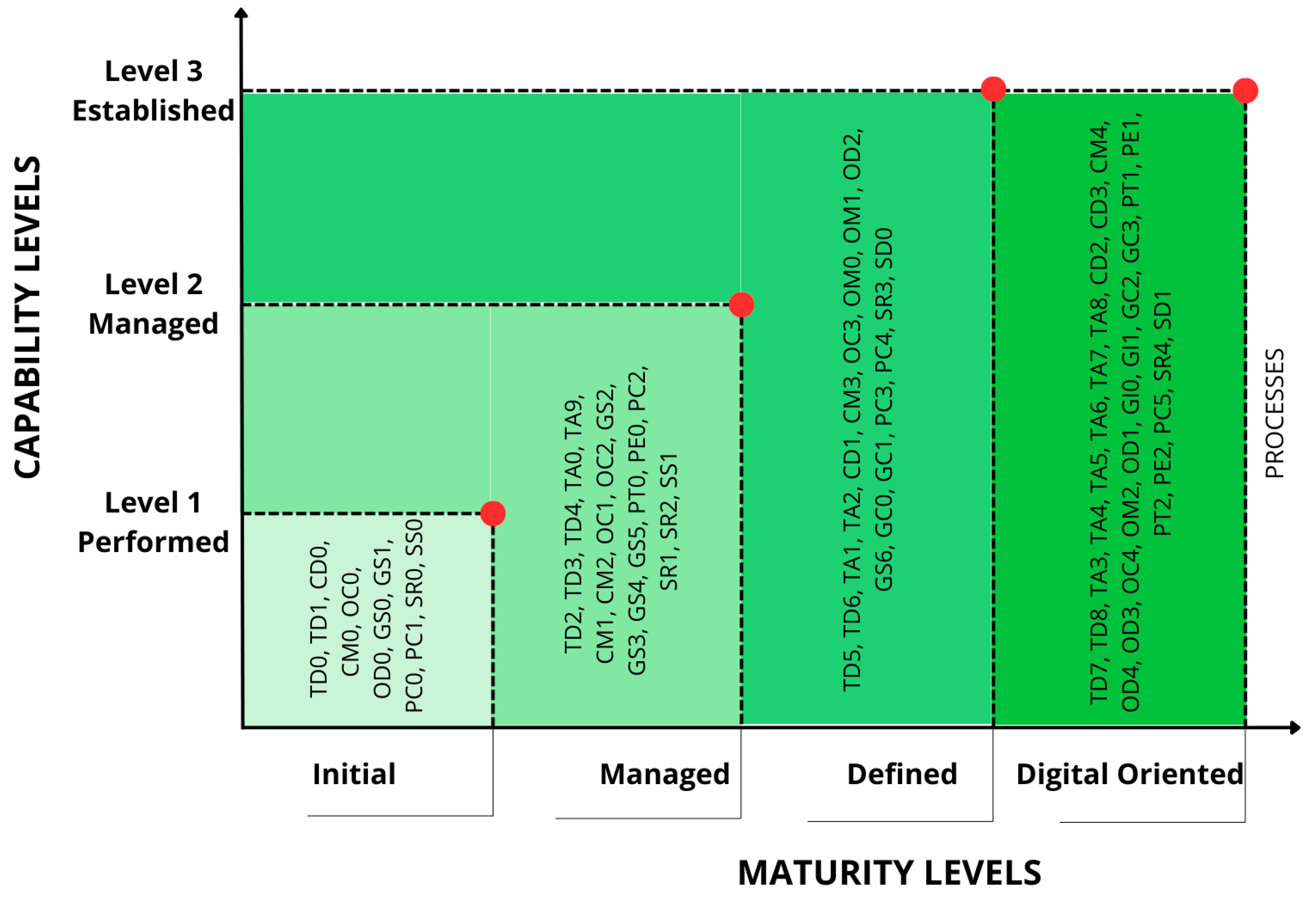
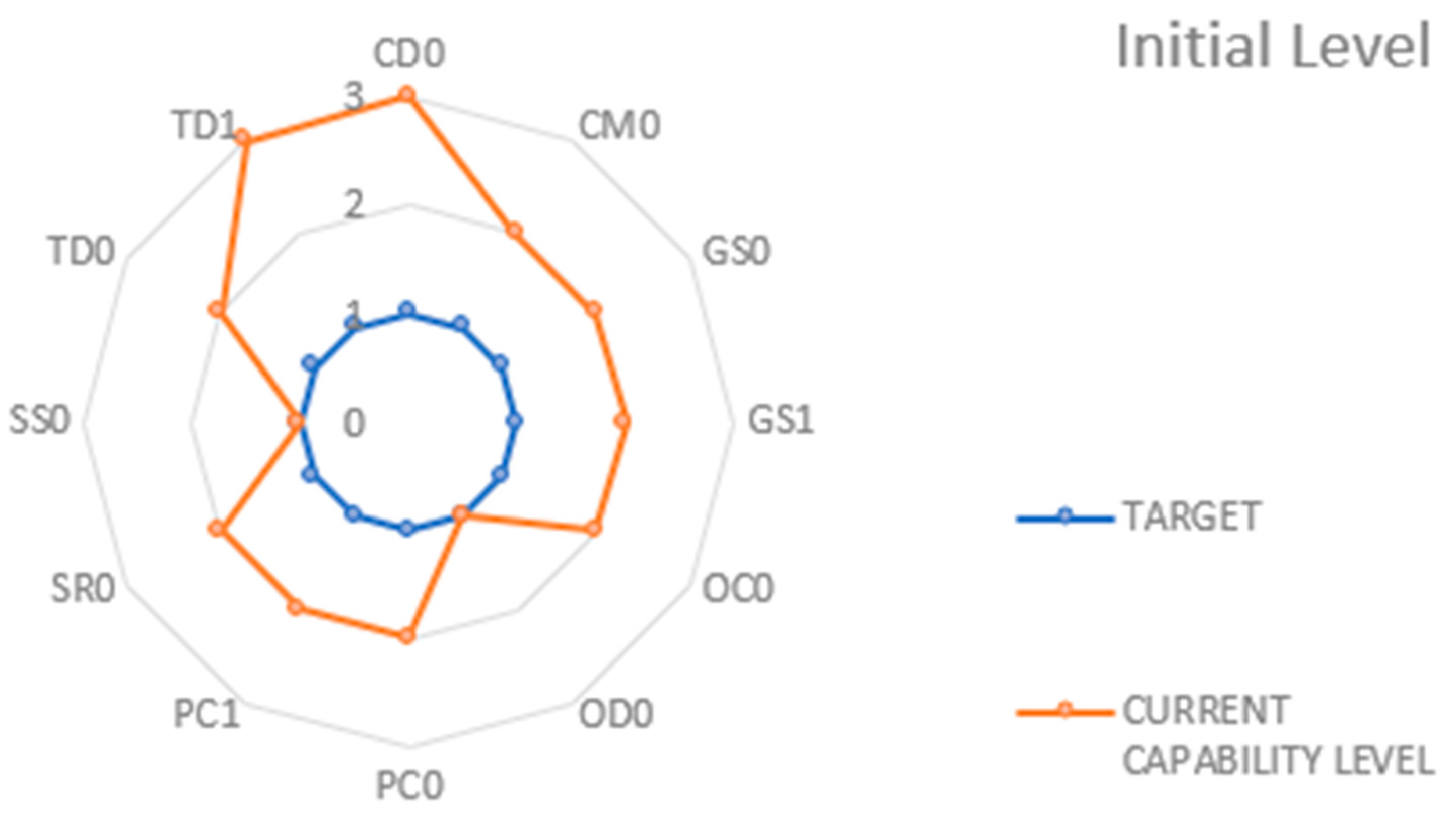
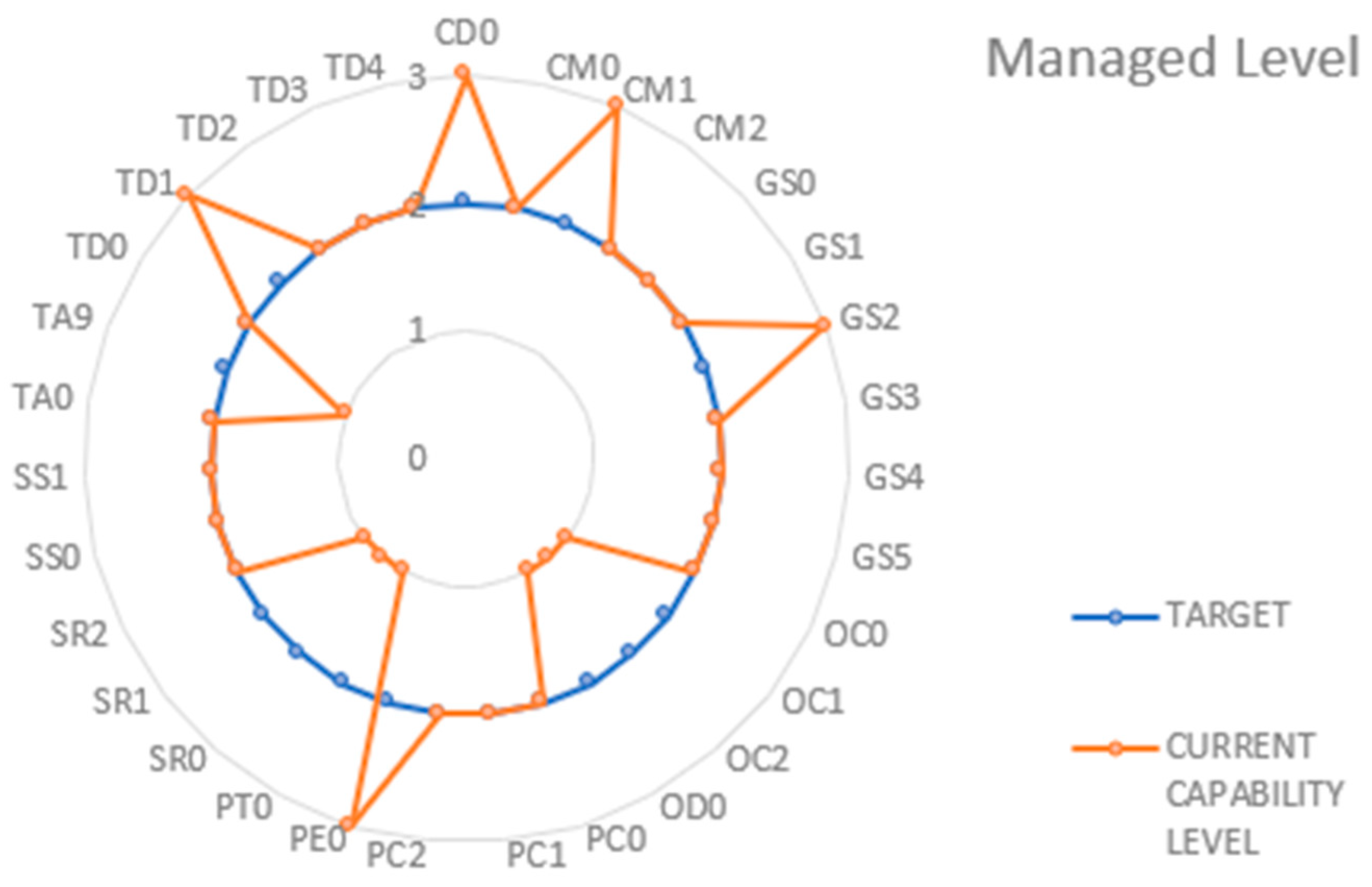

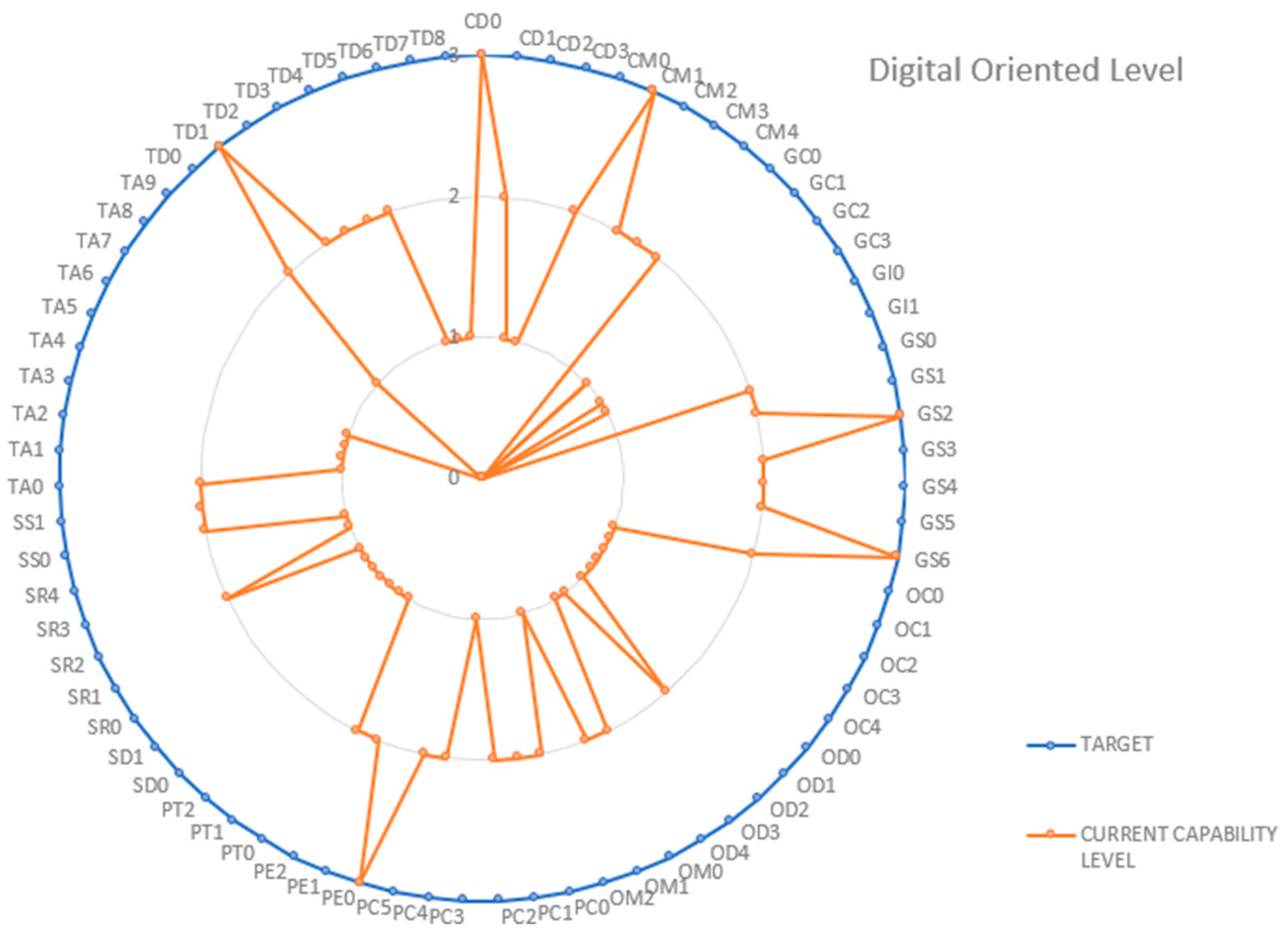
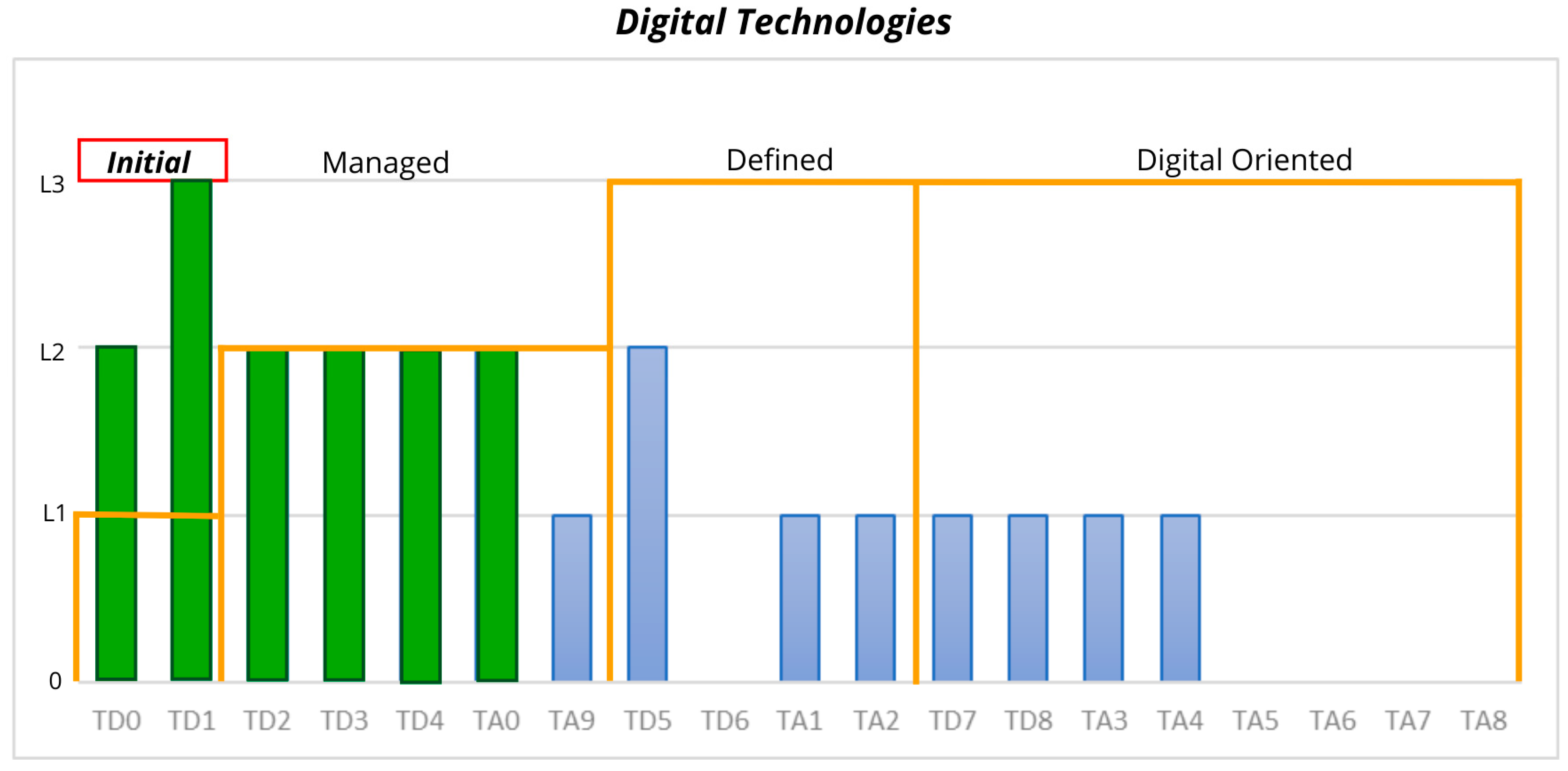
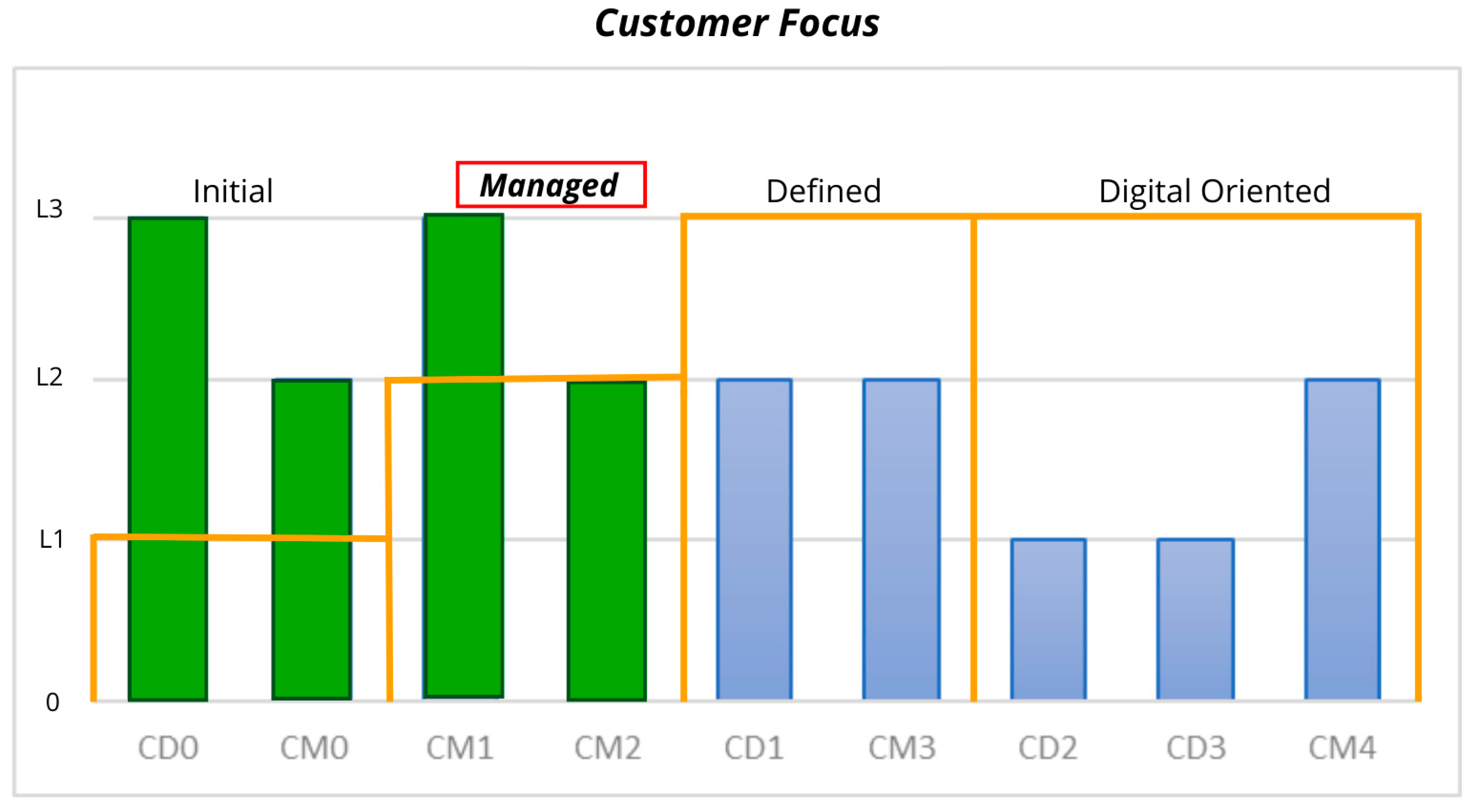
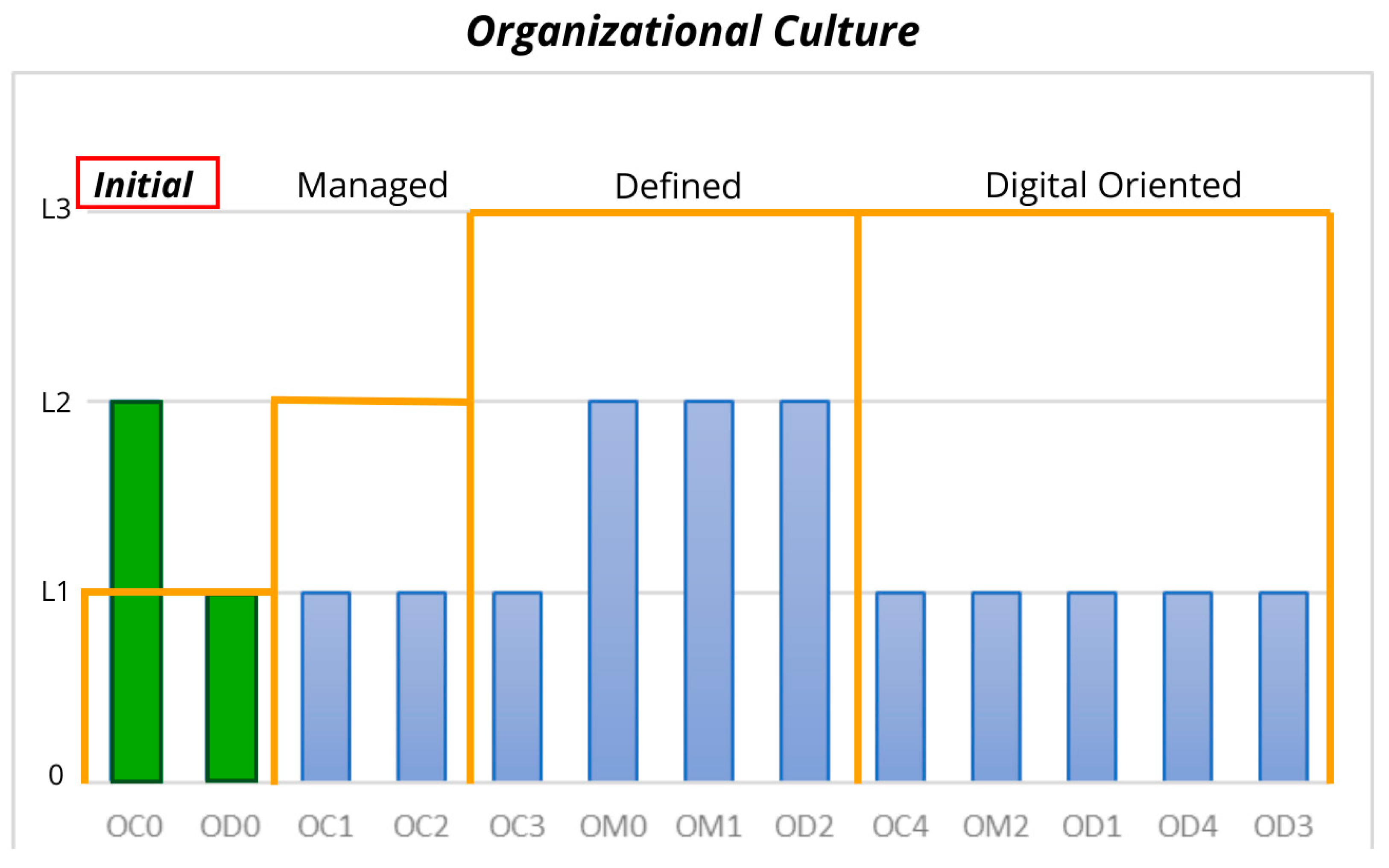
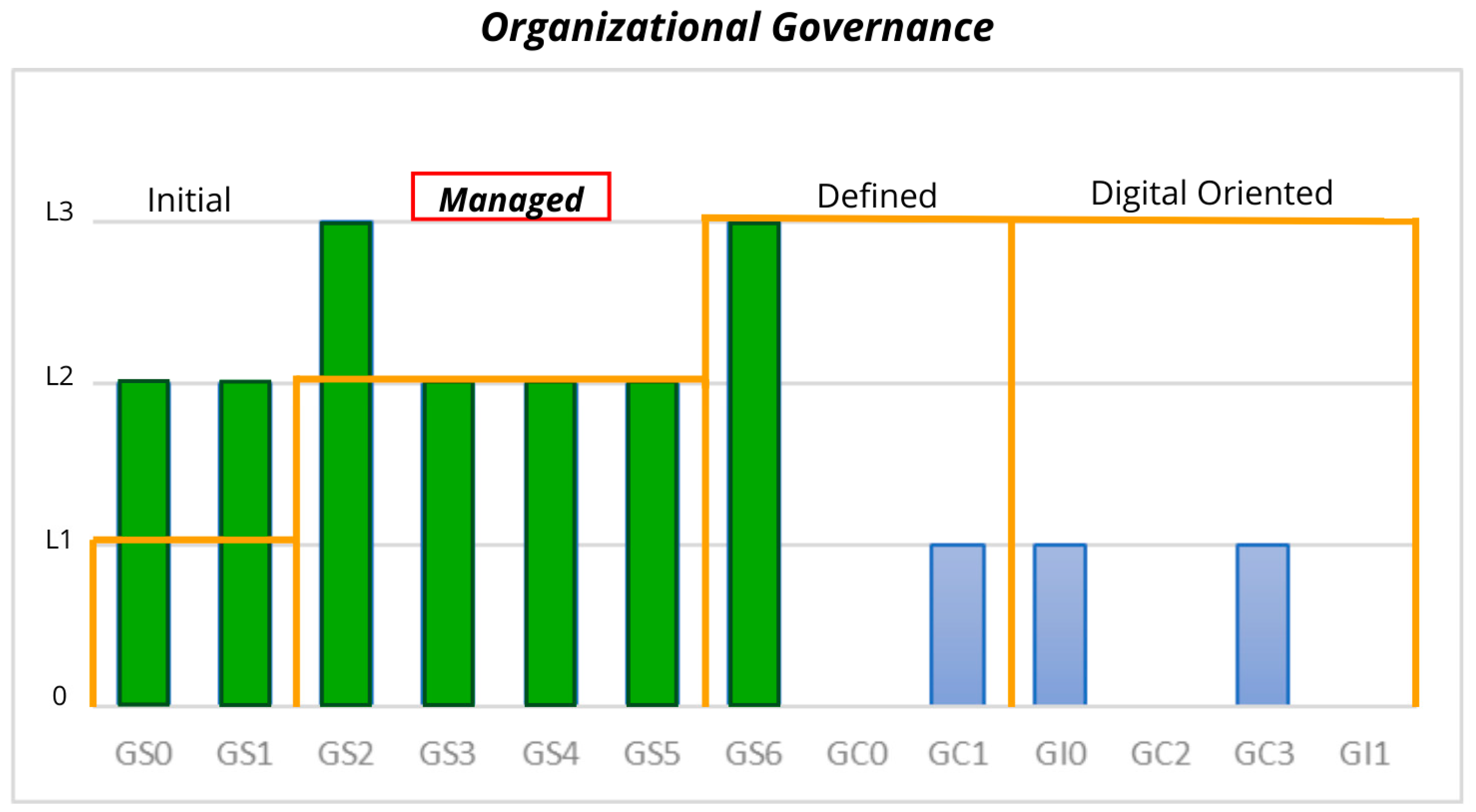
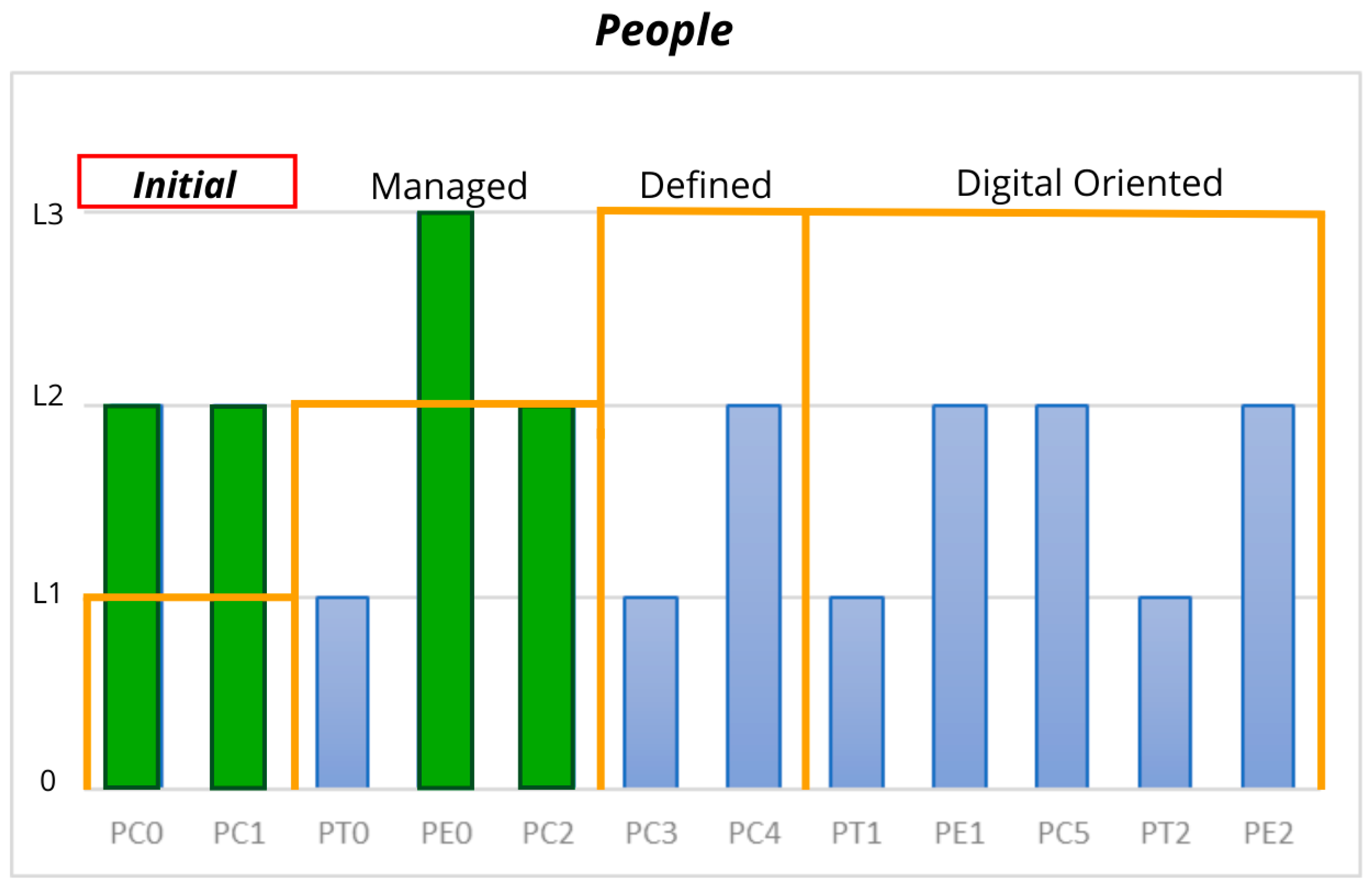
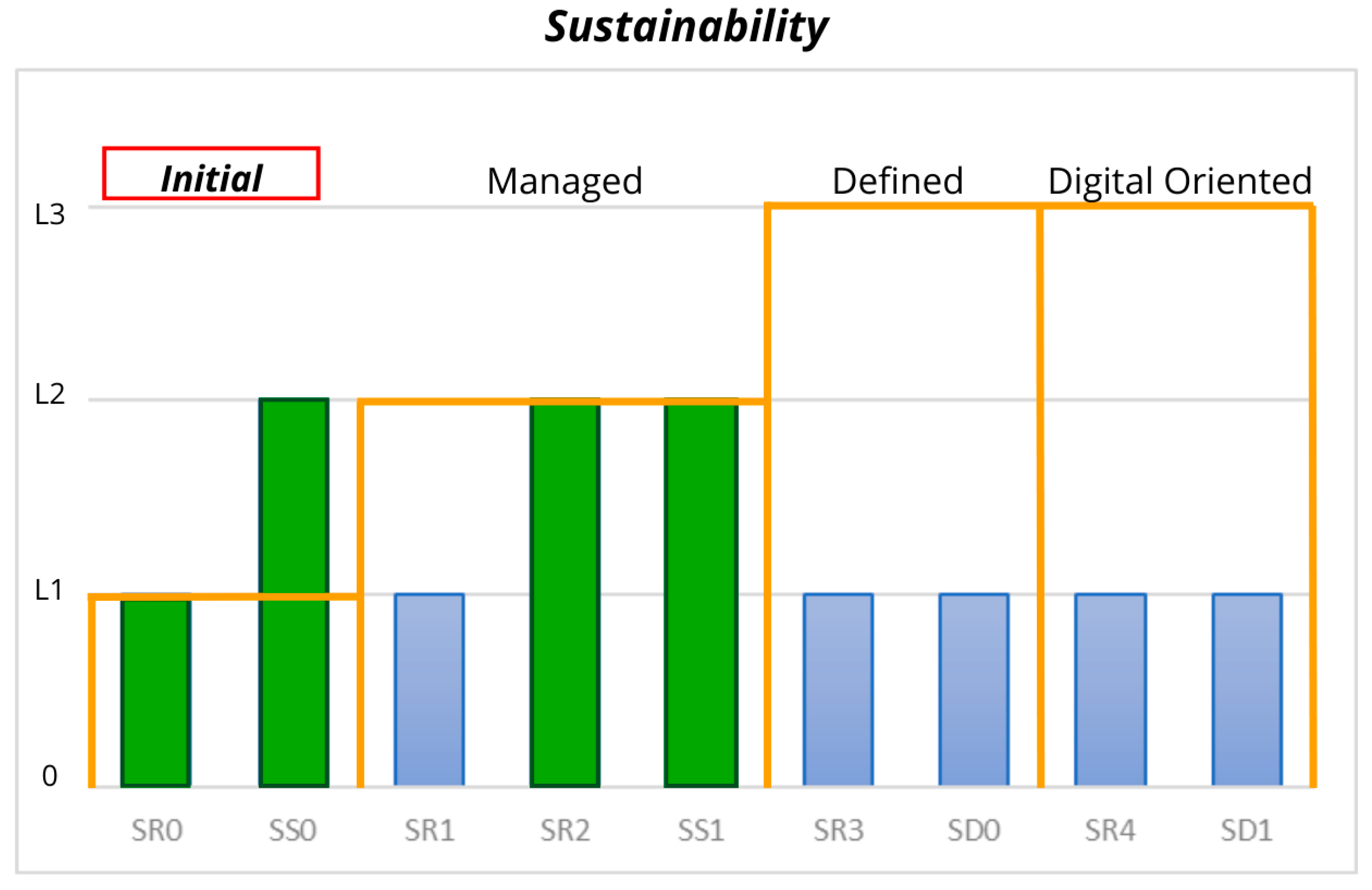
| Keyword Combination | Scopus | Web of Science | Total | |
|---|---|---|---|---|
| Group 1 | “Digital Transformation” AND (“SMEs” OR “Small and Medium Enterprises”) AND (“Sustainab*” OR “Sustainable Development”) | 100 | 53 | 153 |
| Group 2 | “Digital Transformation” AND “Roadmap” AND (“SMEs” OR “Small and Medium Enterprises” OR “Sustainable Development” OR “Sustainab*”) | 122 | 56 | 178 |
| Filtering Procedures | Number of Articles | |
|---|---|---|
| Group 1 | Group 2 | |
| Duplicate papers deleted | 69 | 73 |
| Exclusion by document type (conference paper; book and book chapter) | 24 | 49 |
| Deletion of articles outside the theme | 18 | 44 |
| Total articles deleted | 108 | 166 |
| The resulting number of articles in the portfolio | 48 | 12 |
| Key Factor | Ref | Process |
|---|---|---|
| Digital Infrastructure and Readiness | TD0 | Use Basic Technologies |
| TD1 | Manage Social Media Platforms | |
| TD2 | Implement IT Infrastructure | |
| TD3 | Manage Information Systems | |
| TD4 | Ensure Connectivity | |
| TD5 | Guarantee Interoperability | |
| TD6 | Integrate Digital Technology | |
| TD7 | Facilitate Industrial System Integration | |
| TD8 | Unify Horizontal and Vertical Software Integration | |
| Digital and Advanced Technologies | TA0 | Utilize Cloud Computing |
| TA1 | Apply Artificial Intelligence (AI) | |
| TA2 | Utilize Data Analytics | |
| TA3 | Conduct Simulations | |
| TA4 | Deploy Internet of Things (IoT) | |
| TA5 | Implement Augmented Reality | |
| TA6 | Secure with Cybersecurity using Blockchain | |
| TA7 | Utilize Big Data | |
| TA8 | Utilize Machine Learning | |
| TA9 | Create Digital Twins |
| Key Factor | Ref | Process |
|---|---|---|
| Digital Technologies and Platforms | CD0 | Use of Digital Platforms |
| CD1 | Implement e-Commerce | |
| CD2 | Provide Real-time Information | |
| CD3 | Manage Product Traceability | |
| Marketing and Customer Relationship | CM0 | Share Information and Interact with Customers |
| CM1 | Develop Digital Marketing Strategies | |
| CM2 | Promote Customer Engagement and Loyalty | |
| CM3 | Enhance Customer Experience | |
| CM4 | Customize Products and Services |
| Key Factor | Ref | Process |
|---|---|---|
| Culture and Innovation | OcC0 | Foster a Culture of Innovation |
| OcC1 | Develop Digital Culture | |
| OcC2 | Encourage Open Innovation | |
| OcC3 | Promote an Adaptive Organizational Culture | |
| OcC4 | Implement Internal Innovation Processes | |
| Change Management and Adaptability | OcM0 | Apply Change Management Practices |
| OcM1 | Improve Organizational Adaptability | |
| OcM2 | Build Organizational Change Capacity Processes | |
| Digitalization and Technology | OcD0 | Digitalization Well-accepted by the Workers |
| OcD1 | Drive Digitalization of Processes and Services | |
| OcD2 | Adopt E-business Strategies | |
| OcD3 | Advance Corporate Sustainability and Digitalization | |
| OcD4 | Implement Agile Manufacturing and Innovation |
| Key Factor | Ref | Process |
|---|---|---|
| Strategy | GS0 | Develop Strategic Vision |
| GS1 | Manage Organisational Leadership | |
| GS2 | Manage Strategies and their Financial Aspects | |
| GS3 | Evaluate Overall Performance | |
| GS4 | Formulate Digital Strategy | |
| GS5 | Define Differentiating Ideas | |
| GS6 | Define Portfolio | |
| Innovation and Research | GI0 | Invest in Innovation |
| GI1 | Conduct R&D (Research and Development) | |
| Collaboration and Engagement | GC0 | Establish Partnerships with Educational Institutions |
| GC1 | Engage Stakeholders | |
| GC2 | Seek Government Support | |
| GC3 | Forge Collaboration and Partnership |
| Key Factor | Ref | Process |
|---|---|---|
| Technical Capabilities and Skills | PT0 | Develop Digital Skills for all Employees |
| PT1 | Enhance Information and Digital Technology Expertise | |
| PT2 | Manage Human–AI Cooperation | |
| Education and Continuous Development | PE0 | Manage Education and Capacity Building |
| PE1 | Manage Sustainable Learning Management | |
| PE2 | Promote Continuous Training | |
| Communicationand Team Management | PC0 | Ensure Support from the Top Management Team |
| PC1 | Develop Management Skills | |
| PC2 | Exercise Transformational Leadership | |
| PC3 | Encourage Employee Participation | |
| PC4 | Ensure Effective Communication | |
| PC5 | Manage Work Teams (inter/intra communication) |
| Key Factor | Ref | Process |
|---|---|---|
| Resource Efficiency and Environmental Impact Reduction | SR0 | Implement Green IT Practices |
| SR1 | Monitor Carbon Footprint | |
| SR2 | Optimize Resource Efficiency | |
| SR3 | Implement Digital Environmental Monitoring | |
| SR4 | Utilize Renewable Energy Sources | |
| Sustainable Supply Chain and Circular Economy | SS0 | Adopt Sustainable Procurement |
| SS1 | Promote Circular Economy Practices | |
| Sustainable Design and Reporting | SD0 | Conduct Sustainability Reporting |
| SD1 | Sustainable Product Design |
| Capability Levels | Description |
|---|---|
| Level 0 (incomplete) | The process is either not implemented or not utilized effectively, with little to no evidence of a systematic approach to achieving its objectives. |
| Level 1 (performed) | The process is functioning as intended with basic execution, but it may lack formal planning and control. |
| Level 2 (managed) | The process is now implemented in a managed way, including planning, monitoring, and adjustments as needed. |
| Level 3 (established) | The managed process is now implemented with a defined approach that ensures consistency, follows established practices and standards, and effectively achieves its intended outcomes. |
| Focus on SMEs | Dimensions Approached | Levels of Organizational Planning Addressed | ||||||||
|---|---|---|---|---|---|---|---|---|---|---|
| Paper | Digital Technologies | Customer Focus | Organizational Culture | Organizational Governance | People | Sustainability | Strategic | Tactic | Operational | |
| SDT-SMEs Roadmap | √ | √ | √ | √ | √ | √ | √ | √ | √ | √ |
| [29] | √ | √ | √ | √ | √ | |||||
| [32] | √ | √ | √ | √ | √ | √ | √ | |||
| [31] | √ | √ | √ | √ | ||||||
| [35] | √ | √ | √ | √ | √ | |||||
| [34] | √ | √ | √ | √ | √ | √ | √ | |||
| [33] | √ | √ | √ | √ | √ | √ | √ | |||
| [30] | √ | √ | √ | √ | √ | √ | ||||
| [36] | √ | √ | √ | √ | √ | |||||
| [37] | √ | √ | √ | √ | √ | |||||
| [38] | √ | √ | √ | √ | √ | √ | √ | √ | ||
| [39] | √ | √ | √ | √ | √ | √ | ||||
| [40] | √ | √ | √ | √ | √ | √ | √ | √ | ||
Disclaimer/Publisher’s Note: The statements, opinions and data contained in all publications are solely those of the individual author(s) and contributor(s) and not of MDPI and/or the editor(s). MDPI and/or the editor(s) disclaim responsibility for any injury to people or property resulting from any ideas, methods, instructions or products referred to in the content. |
© 2024 by the authors. Licensee MDPI, Basel, Switzerland. This article is an open access article distributed under the terms and conditions of the Creative Commons Attribution (CC BY) license (https://creativecommons.org/licenses/by/4.0/).
Share and Cite
Mick, M.M.A.P.; Kovaleski, J.L.; Mick, R.L.; Chiroli, D.M.d.G. Developing a Sustainable Digital Transformation Roadmap for SMEs: Integrating Digital Maturity and Strategic Alignment. Sustainability 2024, 16, 8745. https://doi.org/10.3390/su16208745
Mick MMAP, Kovaleski JL, Mick RL, Chiroli DMdG. Developing a Sustainable Digital Transformation Roadmap for SMEs: Integrating Digital Maturity and Strategic Alignment. Sustainability. 2024; 16(20):8745. https://doi.org/10.3390/su16208745
Chicago/Turabian StyleMick, Marcela Marçal Alves Pinto, João Luiz Kovaleski, Rafael Luis Mick, and Daiane Maria de Genaro Chiroli. 2024. "Developing a Sustainable Digital Transformation Roadmap for SMEs: Integrating Digital Maturity and Strategic Alignment" Sustainability 16, no. 20: 8745. https://doi.org/10.3390/su16208745
APA StyleMick, M. M. A. P., Kovaleski, J. L., Mick, R. L., & Chiroli, D. M. d. G. (2024). Developing a Sustainable Digital Transformation Roadmap for SMEs: Integrating Digital Maturity and Strategic Alignment. Sustainability, 16(20), 8745. https://doi.org/10.3390/su16208745





